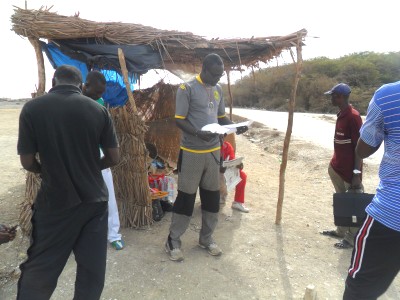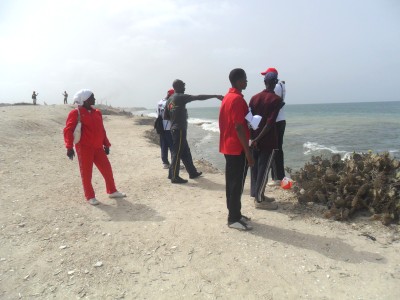by Doudou Ndiaye, Deputy Director Santa Yalla School
In the context of collaboration between Nantes, France, and Rufisque, Senegal, days of sharing between the initiators of the cooperation took place in the second half of June 2013 involving l'Association Solidarités Nantes-Rufisque, the Association for Youth Animation and Sport Development in Rufisque (AAJDSR - Association pour l'Animation de la Jeunesse et le Developpement des Sports a Rufisque) and the Education and Training Inspectorate Rufisque Commune.

On that Monday, teachers could become familiar with the compass. To this effect, Alassane and Doudou presented the compass, explained its operation and conducted some exercises to determine the azimuth in the auditorium before a big game inside the Lycée Moderne in Rufisque.
Alassane and Doudou also went to Cap des Biches for a prospective meeting. There, we laid the groundwork in preparation for the activity "tracking and orientation" scheduled for the Tuesday, June 25, 2013.
On Tuesday, we all went to Cap des Biches for azimuth surveys, drawing the site plan and to identify environmental problems, particularly those harmful to the marine ecosystem. 
As a result, the instructions were to choose an environmental problem, to ask questions and consider action. So the context is as follows:
How the modern world leads to many nuisances that affect the environment. The resulting problems are many and you can see them daily on television and in newspapers. The study of these problems is an exciting activity that will make you aware of the need for action to preserve or restore the quality of the environment.
The challenge presented is the same for the two working groups: There are interactions between humans and the environment. People can act, for good or evil, on all elements of the natural environment. For example, we may contaminate the water of the sea by industrial plant discharges or removing sand from the sea.
Conversely, the natural environment may impact on humans. Health can be affected by poor water quality. The living conditions deteriorate. Houses may collapse.
|
Coastal erosion |
Marine pollution |
|
Causes |
|
|
The type of soil (clay) |
Smoke dischage of the electricity utility |
|
Extraction of sand from the beach |
Petroleum pollution on the beach |
|
Effects |
|
|
The sea advances |
Respiratory diseases |
|
Collapse of houses |
Fish becoming scarce |
|
Migration of people |
Deterioration of the algae |
|
Proposed solutions |
|
|
Construction of protective dykes |
Establish and enforce legislation and rules |
|
Establish and enforce legislation and rules |
Filter / clean the discharge |
|
Educate children and adults |
Fine perpetrators |
|
Surveillance brigades |
Surveillance committees |








